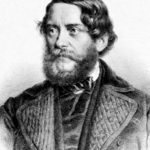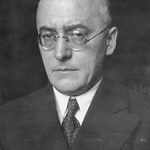The 19th and 20th centuries were the twenty decades during which men (and some women) astonished the world by making uncountable fortunes in the vast territories of the United States. Many of these fortunes remained and remain even in the over-taxed 21st century. Here we deal with financiers; but some of those colossal, Croesus-like money boxes came from meat-packing, cotton, the invention of the canning industry, timber, building and builder’s materials, manufacturing of paint, motor cars and the railway,, glass and glassware; even buttons and ink.
John P. Morgan was a scion of an already rich banking family. John made his first million or so by investing heavily in railroads after the American Civil War (q.v.) and the crushing of dangerous Native American tribes. He was able to found his own investment banking house in 1895 when he was forty-eight. He named it J.P. Morgan and Co.
Morgan was a symbol of finance capitalism. If dissidents wish to find a scapegoat, he is easily identified as a leader in finance capitalism, whereby financiers have come to control the economy of countries like the United States, and now India and Japan. China, also a tremendous success, cannot be a member of the club because it is officially still Communist. Communists loathe capitalists and vice-versa.
Morgan kept businesses, especially the railways going in the difficult 1890s, by loans, but especially by placing his own representatives on boards. But he was not a monster like Robert Maxwell. He disliked inefficiency yes, but he also disliked cut-throat competition, and he forced many American capitalists to put manners above ambition, at least in public. He was almost universally hated by politicians.
Between 1893 and 1913 (one year before the start of World War I) he was directly and openly behind all mergers in the railway companies, shipping, the electrical industry and telephone systems. His masterpiece was the formation of United Steel in 1901, the first billion-dollar Trust, which specialists say has dominated the steel industry ever since.
He was responsible for the system of inter-locking directorships in his 112 corporations, which had assets of well over $22 billion in the early part of the 20th century. In today’s terms this figure is incalculable.If the US Treasury itself needed a spot of cash, it would come to J.P. Morgan for a loan, just as the governments of Britain, France, Germany and Italy would do with the Rothschilds. It was Morgan who stabilized the currency crisis of the 1870s, gold crises in the 1890s, and Wall Street panic in 1907.
By 1910, all leading capitalists were directly associated either with Morgan, or his ‘rival’ J.D. Rockefeller. On the more human side, Morgan owned a unique art collection, almost all of which he left in his will to the Metropolitan Museum of Art in New York City, of whose committee he was President. He died in 1913.
John Davison Rockefeller Rockefeller and US industrialist Andrew Carnegie were different from J.P. Morgan in that they did not hail from already wealthy families. Rockefeller (born 1839) was the son of a door-to-door patent medicine salesman. He went to work in his teens as a clerk, then moved into the meat packing industry, in which he did not stay long, for he read the newspapers and saw that oil producers were at the mercy of oil refiners and shippers. Shortly after getting himself into the oil industry Rockefeller found that he could control both, so that he could in dictate terms to the producers.
In 1870 he founded Standard Oil of Ohio, which became the first of the so-called Oil Trusts. Another admirer of efficiency, he concentrated on efficient production, ploughing back his profits into the corporation. Ruthlessly, he followed standard business practices of the day to push competitors out of business. As a result he was much feared, and the name Rockefeller was associated for decades with hardly scrupulous business methods, not say ruthlessness.
He also despised industrial espionage, rebates on the railways and any kind of price-cutting. He swore he would wipe it all out and he did. By 1898 Standard Oil refined nearly 85% of all oil produced in the US, as well as producing 33.5% of it!
His Standard Oil Trust was much copied in other industries, for example electricity, but Rockefeller had made enemies. The Trust was dissolved by order of the Ohio Supreme Court in 1892. The enemies had struck; and struck hard, but they hardly knew who they were dealing with. The Ohio trust was promptly replaced by the Standard Oil Company of New Jersey.
Everybody got together for an almight push (or putsch) and in 1911 the New Jersey trust was also outlawed, this time by the US Supreme Court. None of this stopped Rockefeller claiming to be the richest man in the world with a personal fortune of more than a billion dollars (one thousand million). Like his fellow guy-who-made-it-from-nothing Andrew Carnegie, he gave away immense fortunes, perhaps more than $500 million. This included donations to the University of Chicago for use in medical and educational research. The Rockefeller Foundation (which I believe includes the Rockefeller Center in New York), was established in 1913, so that J.D’s adventures in philanthropy might continue after his death, which occurred in 1937, when he was ninety-eight.










Leave A Comment